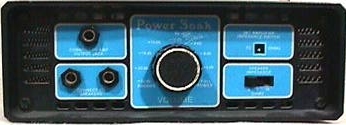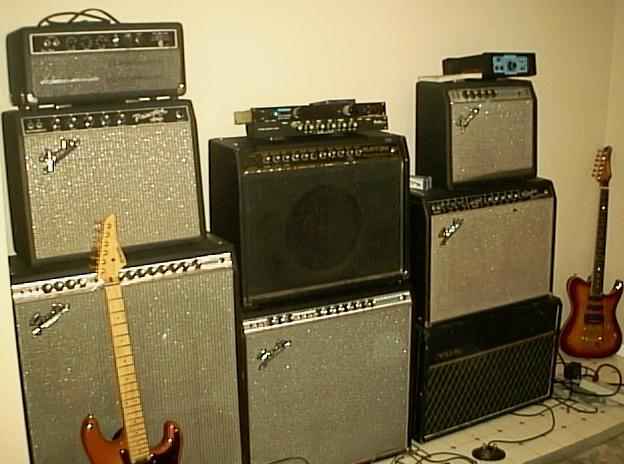Home (amp tone and effects placement)
Scholz - Power Soak


from http://www.semo.net/crossfire/axe/sneaky.htm GAS page
This unit has been reissued and might or might not be available new. It's purely resistive, not inductive, and everyone seems to agree that it's fairly good but not the greatest, which is why I didn't place a high priority on this page. It should be trivial to find out info about it online, because it has been around so long and has become a point of reference, almost synonymous with the term "soak".
Reviewed in Best of Guitar Player, and maybe Guitar Player. See my Books page. The 2-column review pretty much just says: "For 4 or 8 ohm cab. Up to 32 dB attenuation in 8 steps. At settings between -12 and -32 dB, drives a mixer. At -32dB, you can use the Soak's headphone out. Doesn't sound as good as reactive (Resistor/Inductor) loads. A diminished presence, snap, and sizzle compared to directly driving the guitar speaker."
Legends of Guitar: The Quest for Ultimate Tone. Best of Guitar Player. Sonic secrets -- Hendrix, Clapton, Van Halen, Stevie Ray, Slash, & more. Distortion tips. Eq- craig anderton. Decoding distortion. R. Aspen Pittman. Eric Johnson. Tone factors in solidbody guitars. 1995. Has a review of soaks, which appeared in Guitar Player Aug 1993. Covered:
- Scholz Power Soak $200 list
- Marshall Power Brake $350 list
- Groove Tubes Speaker Emulator II $500 list
- Harry Kolbe Soundsmith - Silent Speaker $250 list, The Attenuator $150 list
- ADA MicroCAB $220 list
- Hughes & Kettner - Red Box Mk III $130 list
Boston page - "In 1980 Tom started his own firm to design and manufacture signal processing devices for musical instruments. This company, Scholz Research & Development, first created the Rockman line of products to help achieve that trademark BOSTON guitar sound (which had previously required extensive vintage tube circuits) using solid state electronics. The first device Tom manufactured was the Power Soak. This device, a little box that allows your amp to achieve great sound at low volumes, quickly became a hit. In 1982, SR&D released the Rockman headphone amp, a small device the size of a peanut butter sandwich which has a sound as big as a wall of amplifiers (and won't wake the neighbors!). Since then, SR&D has manufactured an extensive line of analog signal processors for guitar. Ultimately, the Rockman products revolutionized the way guitars were to sound and were to be recorded; Rockmans can now be heard on hundreds of commercial albums and hit records. Over the years, Tom has received some two-dozen electronic, mechanical, and electro-mechanical design patents. Tom sold the Rockman line to Dunlop Manufacturing in 1995, and subsequently closed SR&D.
http://www.eetimes.com/news/98/1004news/scholzside.html - Scholz reinvented rock-processing equipment - by By Larry Lange -
Though the creative force behind the rock group Boston, Tom Scholz had an engineering problem. Because of the limitations of mid-1970s guitar-processing equipment, he couldn't quite get the majestic rock music sound swirling around in his head to translate easily to tape.
In order to get the distorted, overdriven power-rock sound out of a guitar amplifier, technicians were saddled with recording then-state-of-the-art tube amps at maximum volume to achieve the desired "heavy" effect. Scholz found that technique to be less than elegant, so in true engineering form, he addressed the problem with an ingenious end-around.
Placing a series of resistors between the output of a high-level (100-W) tube amp and a speaker cabinet, Scholz found a way to "soak up" an amp's output - though it could still be pinned at maximum volume, for full distortion effect. He had created what he called the Power Soak.
The first crack - Early versions of the Power Soak had settable input and output impedances and a rotary knob on the front that allowed a player to dial the volume down. Though the amplifier could crank out at 100 W, a player could actually plug headphones into the amp and play at a comfortable level. Scholz's company, SR&D, released the invention publicly in 1980.
Made by the company "Tom Scholz", Model PS3.
120 max watt input
Scholz Research Development Inc.
1560 Trapelo Rd.
Waltham, Ma 02154
Barre generally uses Schecter guitars for a clean sound and Tom Anderson guitars for nastier tones, plugged into either Soldano or Marshall amps. As for Marshall amps, he prefers those that don't have a master-volume control. "The master-volume models are just pure distortion--too much" says Barre. "Also, I don't use the tone controls on my old Marshalls because usually they just add hiss."
To achieve his classic rhythm-guitar crunch at low volumes, Barre relies on two additional pieces of gear, a Scholz Power Soak and a Boss compressor/limiter stomp box. "I don't play loud at all, so the Power Soak is a good resource when you want chunky, overdriven chords on the backing tracks," explains Barre. "For example, I set my Soldano amp to 41�2 and the master volume on 7, and then put the Power Soak straight in between the amp and the speaker. Even cranked all the way up, the unit is whisper quiet."
song "power soak" - at johnny_beane
official product page - none. emailed closest company, Dunlop. They said they had no plans to reissue the Power Soak.
Research links
scholz "power soak"
+scholz +"power soak"
Click these custom links to find the latest information and discussion about this product.
Article at Harmony Central - not found
user reviews for this manufacturer at Harmony Central
search newsgroup threads at Remarq.com
Amptone.com ultra gear-search page
Home (amp tone and effects placement)